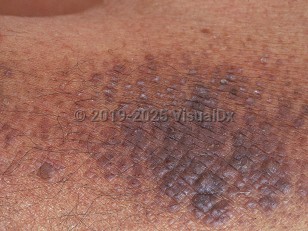Lichen amyloidosis
Alerts and Notices
Important News & Links
Synopsis

Lichen amyloidosis (LA) is the most common form of primary cutaneous amyloidosis (a category which also includes macular and nodular amyloidosis, poikiloderma-like cutaneous amyloidosis, primary cutaneous amyloidosis of the auricular concha, and the exceedingly rare entity of amyloidosis cutis dyschromica). In LA, a proteinaceous material, amyloid, which is derived from keratinocytes, is deposited in the superficial dermis without involvement of other tissue.
While the cause of LA is incompletely understood, it is associated with, and probably caused by, friction and scratching with fingernails or implements such as towels or brushes.
Clinically, LA manifests as hyperpigmented papules that coalesce to form thick plaques with a "seafloor-like" rippled appearance. The most common location is the pretibial area, but the thighs, forearms, and back can also be involved. LA and macular amyloidosis (MA) are believed to exist on a spectrum and are mainly differentiated by the nature of the primary lesion (papules and plaques in LA and macules and patches in MA) and histopathologic findings. Some patients also display features of both LA and MA, which is termed "biphasic amyloidosis."
LA is intensely pruritic. LA has been reported in association with a few syndromes, particularly multiple endocrine neoplasia type 2A (Sipple syndrome). LA in this syndrome is usually localized to the back in the intrascapular area, and it is histologically and biochemically identical to other forms of keratinocyte-derived LA unassociated with syndromic disease.
While the cause of LA is incompletely understood, it is associated with, and probably caused by, friction and scratching with fingernails or implements such as towels or brushes.
Clinically, LA manifests as hyperpigmented papules that coalesce to form thick plaques with a "seafloor-like" rippled appearance. The most common location is the pretibial area, but the thighs, forearms, and back can also be involved. LA and macular amyloidosis (MA) are believed to exist on a spectrum and are mainly differentiated by the nature of the primary lesion (papules and plaques in LA and macules and patches in MA) and histopathologic findings. Some patients also display features of both LA and MA, which is termed "biphasic amyloidosis."
LA is intensely pruritic. LA has been reported in association with a few syndromes, particularly multiple endocrine neoplasia type 2A (Sipple syndrome). LA in this syndrome is usually localized to the back in the intrascapular area, and it is histologically and biochemically identical to other forms of keratinocyte-derived LA unassociated with syndromic disease.
Codes
ICD10CM:
E85.4 – Organ-limited amyloidosis
SNOMEDCT:
718105008 – Lichen amyloidosis
E85.4 – Organ-limited amyloidosis
SNOMEDCT:
718105008 – Lichen amyloidosis
Look For
Subscription Required
Diagnostic Pearls
Subscription Required
Differential Diagnosis & Pitfalls

To perform a comparison, select diagnoses from the classic differential
Subscription Required
Best Tests
Subscription Required
Management Pearls
Subscription Required
Therapy
Subscription Required
References
Subscription Required
Last Reviewed:01/05/2020
Last Updated:05/11/2020
Last Updated:05/11/2020
Lichen amyloidosis

